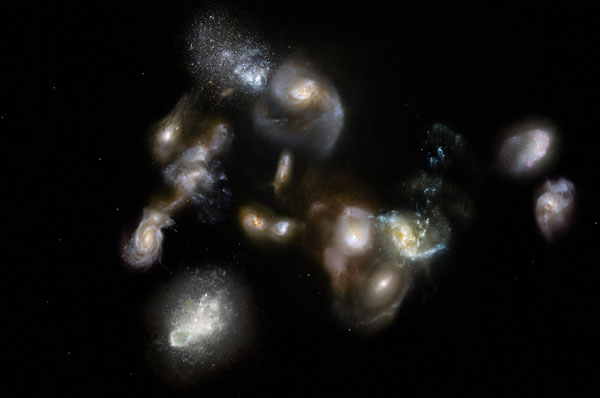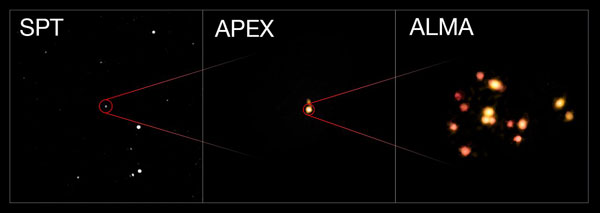At least 14 galaxies are swarming in the early universe, forming a protocluster with the mass of 10 trillion Suns. It might become one of the most massive structures in the universe.
Astronomers have discovered at least 14 galaxies congregating like a swarm of fireflies in the early universe. Each galaxy is alight with stars forming between 50 and 1,000 times more quickly than the Milky Way, and the complex as a whole has the mass of 10 trillion Suns.

ESO/M. Kornmesser
The fact that these galaxies have already come together in such a massive structure just 1.4 billion years after the Big Bang challenges our ideas of how galaxy clusters form.
Clusters are the largest gravitationally bound structures in the universe, containing hundreds or even thousands of galaxies bound by their massive halos of dark matter. But they don’t form all at once — as galaxies come together in the universe’s early years, the forming group is called a protocluster.
A protocluster might ultimately become a galaxy cluster or, depending on its environment, it might fall apart. In the case of SPT 2349–56, the team reports in the April 26th Nature (full text available here), that the 14 galaxies are close enough together that the growing structure will probably survive to the present day. By then (or rather, now), at least some of the 14 galaxies will have merged into a single massive elliptical galaxy, as is typically found in galaxy cluster cores.
The protocluster was first seen as a bright smudge emitting millimeter-wavelength radiation in observations taken by the South Pole Telescope. Follow-up observations by the Atacama Large Millimeter/submillimeter Array (ALMA), combined with Spitzer observations at infrared wavelengths, found that the smudge consisted of at least 14 galaxies forming stars out of huge gas reservoirs.

ESO / ALMA (ESO / NAOJ / NRAO) / Miller et al.
The two brightest galaxies are forming more than a thousand Suns’ worth of stars every year within regions a fifth the size of the Milky Way.
“The fact that this is happening so early in the history of the universe poses a formidable challenge to our present-day understanding of the way structures form in the universe,” says Scott Chapman (Dalhousie University, Canada).
The team compared their observations of SPT 2349–56 to currently available theory. While most protoclusters discovered so far are about as bright as models predict, SPT 2349–56 is 10 times brighter than it should be. Likewise, computer simulations have been unable to produce protoclusters producing as many stars as SPT 2349–56 is.
That said, the authors acknowledge that current models are limited in scope. Allison Noble (MIT), an expert in galaxy cluster formation who wasn’t involved in the study, agrees that current models aren’t broad enough yet to predict such an extreme case. “Simulations have not yet probed large enough cosmological scales to fully assess the uniqueness of this object,” Noble says.
The protocluster may also have been easier to find precisely because it’s so extreme. “Highly starbursting protoclusters are the proverbial ‘needle in a haystack,’” Noble adds, “except the needle in this case is red hot, causing the surrounding hay to glow and thus become easier to see.”
SPT 2349–56 is probably the most distant protocluster known to date, but other recent research has found one nearly as far away. Iván Oteo (University of Edinburgh and European Southern Observatory) and colleagues report another protocluster of 10 dusty, star-forming galaxies existing 200 million years later in the March 20th Astrophysical Journal. Officially known as SMM J004224, this group was first discovered as a blob of infrared emission in images from the Herschel space telescope; ALMA observations later resolved the individual galaxies.
Miller’s team predicts that only 16 such massive structures exist across the entire sky — if so, we’ve already found two of them. These protoclusters will help astronomers understand, and perhaps revise, their ideas of how the universe formed its largest structures.
 7
7
Comments
Anthony Barreiro
April 27, 2018 at 6:30 pm
I feel sad that we won't see this protocluster evolve. General relativity is curiously frustrating. Everything we see at this moment is right now for us, even if it was 12.4 billion years ago over there.
You must be logged in to post a comment.
Jim-Baughman
April 29, 2018 at 1:59 am
I am bemused by the sense of time in this article: “14 galaxies Might Become Universe’s Most Massive Structure”. No mention is made of this cluster’s distance from us, nor could I discover it elsewhere online, but if we are seeing it as it was 1.4 billion years after the Big Bang then it is certainly billions of light years away. So—it isn’t a question of what this cluster “might become”. It “became” something quite long ago in the eons it took that snapshot (baby picture?) to get to us. It may be a pedantic point, but wouldn’t a scientist postulate what actually happened to this cluster, rather than speculate what “might” happen?
You must be logged in to post a comment.
Monica YoungPost Author
April 30, 2018 at 11:09 am
Jim, that's a great question, but unfortunately the laws of physics prevent us from knowing what happened to this protocluster. All we can do is image it in the distant universe (1.4 billion years after the Big Bang, so 12.4 billion years ago) and speculate about what might happen. Indeed, the scientists do think that this protocluster was at an advanced enough stage that it would become a genuine galaxy cluster by the present day. But given that we cannot photograph this particular cluster at the present-day, we can never really know for sure!
You must be logged in to post a comment.
Anthony Barreiro
April 30, 2018 at 1:07 pm
It's curiously frustrating! Darn relativity.
You must be logged in to post a comment.
jonboy
May 1, 2018 at 6:48 am
The statement "It might become one of the most massive structures in the universe." should have read, "It might have become one of the most massive structures in the universe." I'm not being pedantic as this did slightly confuse and irritate me.
You must be logged in to post a comment.
Anthony Barreiro
May 2, 2018 at 3:00 pm
Jon Boy, that depends on whether your copy editor is a Newtonian or an Einsteinian relativist.
You must be logged in to post a comment.
fif52
December 4, 2018 at 4:27 am
what about the gravitational waves this merging would produce, are they at all visible? and what a very detailed artist impression.
You must be logged in to post a comment.
You must be logged in to post a comment.